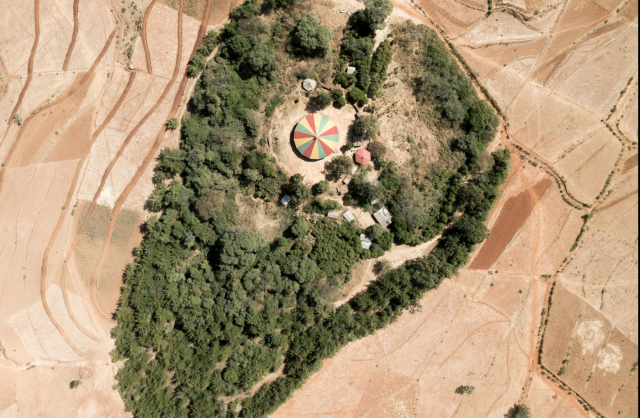 Priests, scientists, and local communities are partnering to save the less than five percent of forests that remain in northern Ethiopia. (Photo: The Debre Mihret Arbiatu Ensesa church, which looks from above like a bright pinwheel, is surrounded by trees. But the hot, dry fields are only a few steps away/National Geographic)
Priests, scientists, and local communities are partnering to save the less than five percent of forests that remain in northern Ethiopia. (Photo: The Debre Mihret Arbiatu Ensesa church, which looks from above like a bright pinwheel, is surrounded by trees. But the hot, dry fields are only a few steps away/National Geographic)
When Alemayehu Wassie Eshete was a boy, he went to church each Sunday. He would make his way along the dry, dusty roads between the wheat fields in his home province in northern Ethiopia. At the end of the trip was the prize: a literal step into another world.
The churches of the Ethiopian Orthodox Tewahido Church—the dominant religious group in Ethiopia, with nearly 50 million members—were almost always nestled in patches of vibrant, shady forest. Forests, the church’s religious belief goes, were like the clothes surrounding the church at the center—as much a part of the religious space as the church building itself. Wassie would step out of the hot sun and into a beautiful, cool world filled with chattering birds and fragrant plants, a small hotspot of both biodiversity and spirituality.
“From an ecological perspective, it’s like going from hell to heaven,” he says. “You go from dry, hot fields into the beautiful forest. Anyone would see that as beautiful, but for me, the forest is more than that. It’s also a spiritual place where nature is perfect, and you pray to God.”
But when Wassie grew up and started studying biology and science, he realized that the forests he loved were few and far between. In school, he was learning about how important forests were for the ecological health of different parts of the world, and he asked himself: Where are our forests, here in northern Ethiopia? Why are there so few patches left?
Over the past century, nearly all of the native forests in the South Gonder province have disappeared, cleared to make way for wheat fields and grazing land—agricultural endeavors that support the region’s rapidly growing population. Many of the church forests, though, remain, protected by their religious stewards and the communities around them. They are tiny fragments of a lost past, and the center of hope for conservation and future restoration.
Read more and see photos at nationalgeographic.com »
—
Join the conversation on Twitter and Facebook.

























